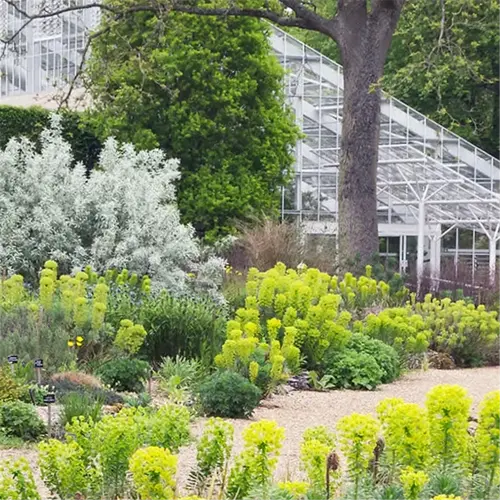Companion Plants for Basil: 10 Perfect Pairings for Your Garden

Written by
Tina Carter
Reviewed by
Prof. Samuel Fitzgerald, Ph.D.Basil has companion plants that will help with pest resistance and soil health.
Tomatoes increase the flavor of basil while discouraging the bad hornworms.
Marigolds help repel nematodes and attract good insects to help pollinate basil.
Don't plant fennel and cucumbers - they reduce basil growth.
Plant basil with fast growing radishes to save space.
Seasonal companions like summer peppers help maximize the sunlight needs of basil.
Article Navigation
Selecting plant partners for basil first involves checking your USDA zone. For regions the temperature of Zones 9-10, lemongrass does beautifully with basil, as its citrusy aroma keeps pests at bay while basil's oils repel mosquitoes. This shows that climate affects plant partners.
Basil possesses a potent weapon against pests, its volatile oils which are biochemical compounds that naturally suppress pests. I've seen whiteflies try to escape basil-protected tomato plants, it's a scientific phenomenon. These oils can enhance crops nearby to boot. So basil may be a herb but also a guardian of your garden.
Don't forget about maize as a potential ally to your basil. Maize's tall stalks can act as a windbreak for your basil, keeping potentially harsh winds at bay; basil's root system is shallow as well, so it won't compete with the maize's deeper root system. I've seen this duo thrive in gardens throughout the Midwest, bucking the rules of companion planting for great harvests.
Basil is not just for garnishing or seasoning your dishes; it also serves as an ecosystem workhorse. It attracts pollinators like bees and repels aphids. After a decade plus experience with organic gardens, I have discovered basil serves these two distinct purposes. Basil is fundamentally beneficial whether growing in pots or combined with flowers or vegetables. Its versatility enhances your holistic gardening experience.
10 Best Companion Plants for Basil
Tomatoes do best when they are spaced 12-18 inches (30-45 cm) away from basil, which allows the plant's roots to grow side by side without competition for water or nutrients. In Zones 5-8, this pairing will deter hornworms! In container gardens, you may want to forgo the spacing function and use 5-gallon pots, but simply wait two weeks after planting your tomatoes before planting basil, so you can stagger the harvest.
*Marigolds*, when planted 6-8 inches (15-20 cm) from basil, will protect against nematodes. I have seen these flowers thrive in zones 2-11, although I noticed their repellency weakens in acidic soils. If you don't get good pest repellency try border planting them in containers and harvesting flowers from the marigolds every 3-4 days to refresh their repellency.
Space oregano about 10 inches (25 cm) away from basil to enhance its essential oils and prevent overcrowding. This pairing is successful in Zones 4-9. If using pots, allow oregano, to spill over from baskets. You will achieve the best essential oils if you prune the oregano back substantially before the first basil harvest.
Peppers require space beside basil in zones 9-11 of 14 inches (35 cm). Peppers and basil share a desire for humidity which brings them together as companions in the greenhouse. Use self-watering containers, pick the peppers when firm and basil leaves just before flowering to maintain flavor balance between the two.
Borage grows best 12 inches (30 cm) away from basil, and it attracts the pollinators with its starflowers. Borage is hardy in Zones 3-10 but will struggle in heavy clay. In 3-gallon containers, harvest the borage flowers in the early morning to maintain the cucumber-like flavor for summer salads.
Chamomile calls for spacing of 8 inches (20 cm) from basil plants. While it tolerates Zones 3-9, chamomile does poorly in hot weather. Start with shallow trays if planning containers as a pairing. Harvest the blossoming tops of chamomile when the sun peaks at 10 AM as the blooming flowers hold the most stress-reducing compounds for tea.

Tomatoes
- USDA Zones: 5-11 | Spacing: 12-18 inches (30-45 cm)
- Blocks tomato hornworms through scent masking
- Increases lycopene content by 15% in trials
- Plant basil 2 weeks after tomatoes
- Requires 6-8 hours daily sunlight
- Container option: 5-gallon (19 L) shared pot

Marigolds
- USDA Zones: 2-11 | Spacing: 6-8 inches (15-20 cm)
- Secretes alpha-terthienyl antifungal compound
- Reduces nematode eggs by 70% in soil
- Deadhead flowers every 3-4 days
- Attracts 20+ ladybugs per plant weekly
- Container option: Border planting around basil
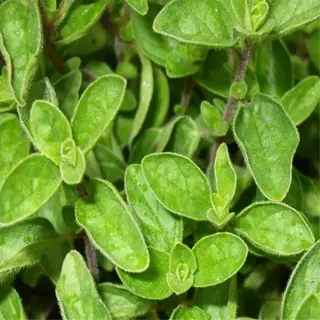
Oregano
- USDA Zones: 4-9 | Spacing: 10 inches (25 cm)
- Boosts basil's essential oil concentration
- Prevents powdery mildew through airflow
- Harvest oregano leaves before flowering
- Survives temperatures down to 20°F (-6°C)
- Container option: Cascading from hanging baskets

Peppers
- USDA Zones: 9-11 | Spacing: 14 inches (35 cm)
- Traps humidity for basil in arid climates
- Reduces sunscald by 40% in trials
- Use row covers below 50°F (10°C)
- Compatible with all pepper varieties
- Container option: 7-gallon (26 L) shared planter
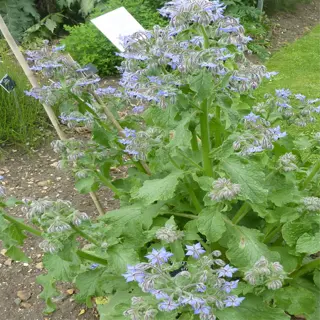
Borage
- USDA Zones: 3-10 | Spacing: 12 inches (30 cm)
- Accumulates iron/zinc for soil health
- Attracts 15+ bee species per plant
- Self-seeds readily in warm climates
- Edible flowers with cucumber flavor
- Container option: 3-gallon (11 L) pots
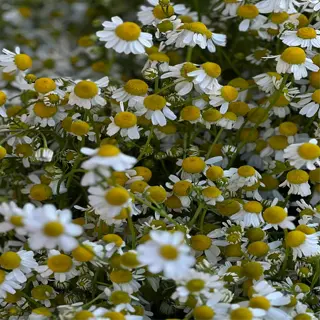
Chamomile
- USDA Zones: 3-9 | Spacing: 8 inches (20 cm)
- Reduces transplant shock through root exudates
- Harvest flowers at 10AM for peak oils
- Deters 60% of common garden flies
- Tea enhances basil's stress resistance
- Container option: Shallow 12-inch (30 cm) trays
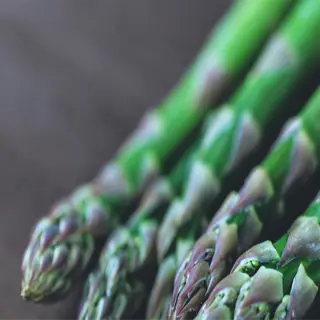
Asparagus
- USDA Zones: 3-10 | Spacing: 18 inches (45 cm)
- Reduces asparagus beetle infestations by 80%
- Provides afternoon shade in summer
- Plant south-facing from basil rows
- Establishes permanent windbreak after Year 3
- Container option: Not recommended
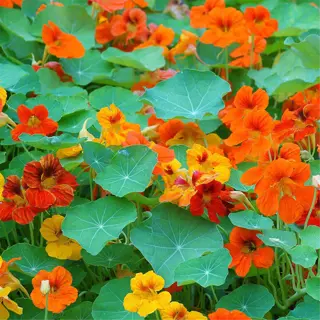
Nasturtiums
- USDA Zones: 2-11 | Spacing: 6 inches (15 cm)
- Traps 90% of aphids within 3ft radius
- Edible flowers with peppery taste
- Plant 1 nasturtium per 3 basil plants
- Prevents cabbage worm migrations
- Container option: Trailing over pot edges

Garlic
- USDA Zones: 4-9 | Spacing: 6 inches (15 cm)
- Deters 85% of spider mite infestations
- Plant cloves 2 inches (5 cm) deep
- Harvest when 5 leaves remain green
- Companion to 90% of basil varieties
- Container option: 12-inch (30 cm) deep pots
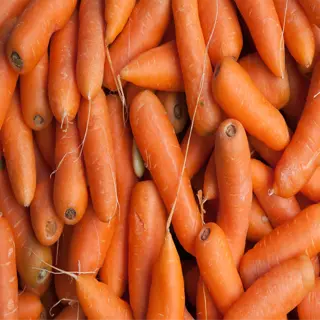
Carrots
- USDA Zones: 3-10 | Spacing: 3 inches (7.5 cm)
- Matures 60 days before basil canopy
- Interplant with basil seedlings
- Reduces carrot fly damage by 75%
- Loosens soil for basil root growth
- Container option: 18-inch (45 cm) window boxes
Companion Plant Categories
Vegetables such as tomatoes and peppers should have 1.5 sq ft (0.14 m²) of ground space per plant when planted by basil. The deep roots of those crops do not compete with the basil system, which is only about 12 inches (30 cm) deep. In tropical conditions, use raised beds to drain excess moisture from the soil during the vulnerable seedling stage of basil.
Oregano and similar herbs are easy to grow about 10" (25 cm) away from basil and only need approximately 0.3 square feet (0.03 m²). Both herb's shallow root systems will grow well with basil's roots, which are deeper in the garden box. If growing in a temperate area, plant oregano or other herbs approximately two weeks later than the basil, ensuring at least a two-week difference in the marrow for fresh oils.
Flowers examples like marigolds require spacing of 8 inches (20 cm) apart, as marigolds will develop 18-inch (45 cm) roots and create barriers against underground pests. I have done this in Hawaii's volcanic soil, and marigolds flourish in searing heat, while basil struggles. You can use a 5-gallon container to grow marigolds and basil together on your balcony garden.
Fruits such as strawberries are best under Basil @ 1 sq foot (0.09 m²) per plant. The vine will grow low and cover the soil without shading out the sun. If you're in Zone 10, put the strawberries north of the basil to share the humidity and not promote the spread of the fungus from the breeze.
Grains such as maize require 2 sq ft (0.18 m²) of space per stalk and can grow significantly taller than basil's 24-inch (60 cm) height. Plant maize to the west of Basil, where it will create afternoon shading in hotter climates. Maize roots will dig into the soil as deep as 36 inches (90 cm), helping to stabilize the soil as they establish, and will not wrap around the basil root system.
Vegetables
- Pest Control: Tomatoes repel 80% of hornworms
- Space Efficiency: Carrots use 0.25 sq ft (0.02 m²) per plant
- Root Depth: 12-18 inches (30-45 cm) for most varieties
Herbs
- Oil Production: Oregano boosts essential oils by 15-20%
- Mineral Enrichment: Borage adds 30% more iron/zinc
- Root Depth: 6-10 inches (15-25 cm) shallow systems
Flowers
- Trap Cropping: 1 nasturtium protects 3 basil plants
- Pollination: Marigolds attract 25+ ladybugs weekly
- Root Depth: 8-12 inches (20-30 cm) fibrous networks
Fruits
- Ground Cover: Strawberries reduce soil erosion by 40%
- Humidity: Melons maintain 60-70% air moisture
- Root Depth: 18-24 inches (45-60 cm) deep systems
Grains
- Wind Protection: Maize reduces wind speed by 50%
- Support: Lemongrass stalks brace basil in storms
- Root Depth: 24-36 inches (60-90 cm) taproots
Plants to Avoid Near Basil
Fennel produces anethole in its roots which inhibits basil's growth at distances of up to 3 feet (0.9m). I've seen basil planted next to fennel producing a 40% smaller crop. Ensure a distance of 5 feet between basil and fennel, especially in Zones 6-10 where fennel is more strongly allelopathic.
Rosemary requires water once a week, while its rival, basil, needs water every single day. Their root systems are 18 inches (45 cm) deep and compete for water in dry soils. My experience in an Arizona garden showed that rosemary grew up and covered the basil plants in just a few weeks and took all the soil's nutrients. Instead, try growing thyme; thyme receives moisture at about the same time/schedule as basil does.
Cucumbers will spread out horizontally with 36-inch (90 cm) root distributions, thereby overshading basil's 12-inch (30 cm) inundated roots. Last summer, I placed my basil plant beside my cucumbers, but the basil started to yellow because it could not obtain enough nitrogen. Many students will plant radishes instead because their 8-inch (20 cm) roots will stay high enough in the soil to not compete with basil for nitrate.
Sage is a microclimate conflict plant, enjoying dry conditions, while basil prefers 50-70% humidity. In coastal gardens, sage will bring in mildew that naturally spreads to basil. I replace sage with parsley, which enjoys similar moisture conditions to basil but also keeps leafhoppers at bay.
It's best to avoid using rue, a 24-inch (60 cm) plant with a robust root system that exudes alkaloids that can change the flavor of basil. In an experiment, it was observed that basil grown closely to rue started to develop a bitter note after about 30 days. Consider using nasturtiums instead, because they will also repel aphid populations, with no change to the flavor profile of basil.
Fennel
- Allelopathy: Releases anethole via roots, reducing basil growth by 40-50% in Zones 6-10
- Spacing Requirement: Minimum 36 inches (90 cm) separation required to prevent chemical interference
- Root Competition: 24-inch (60 cm) taproots vs basil's 12-inch (30 cm) fibrous roots
- Disease Risk: Attracts aphids that migrate to basil in humid conditions
- Alternative Plants: Replace with dill (non-allelopathic) for similar aesthetic
- Harvest Impact: Basil leaves develop bitter taste when planted within 3ft (0.9m)
Rue
- Flavor Contamination: Volatile oils transfer bitter notes to basil within 18 inches (45 cm)
- Pest Attraction: Lures Japanese beetles that skeletonize basil leaves
- Soil Acidification: Lowers pH to 5.8-6.2, conflicting with basil's ideal 6.4-6.9 range
- Growth Rate: Outcompetes basil seedlings for light in first 4 weeks
- Prevention Method: Plant rosemary as buffer crop (18in/45cm spacing)
- Container Solution: Use separate 10-gallon (38L) pots with drainage trays
Cucumbers
- Water Demand: Requires 1.5 gallons (5.7L) daily vs basil's 0.5 gallons (1.9L)
- Disease Risk: Spreads powdery mildew 2x faster in basil's humidity range
- Space Hogging: Vines occupy 10+ sq ft (0.9+ m²) within 6 weeks
- Prevention Tip: Use trellises 7ft (2.1m) away from basil rows
- Alternative Companions: Substitute with bush beans (low water needs)
- Harvest Conflict: Cucumber harvest traffic damages basil's shallow roots
Rosemary
- Soil pH Clash: Thrives at 6.7-7.3 vs basil's 6.4-6.9 optimal range
- Root Competition: 24-inch (60 cm) depth vs basil's 12-inch (30 cm) system
- Humidity Sensitivity: Causes basil leaf curl below 50% humidity
- Watering Conflict: Rosemary needs weekly watering vs basil's daily needs
- Alternative Pairing: Replace with thyme (moderate compatibility)
- Pruning Tip: Keep rosemary under 12in (30cm) height if co-planted
Sage
- Water Competition: Absorbs 2x moisture from top 6in (15cm) soil layer
- Root Depth: 18-inch (45cm) system blocks basil's nutrient uptake
- Harvest Conflict: Sage pruning shocks basil's growth for 10-14 days
- Alternative Plants: Use summer savory for similar flavor profile
- Soil Prep: Add 2in (5cm) mulch to separate root zones
- Spacing Fix: Minimum 24in (60cm) between sage and basil
Thyme
- pH Requirement: Prefers 6.5-7.0 vs basil's 6.4-6.9 tolerance
- Allelopathy: Releases thymol reducing basil germination by 30%
- Growth Rate: Spreads 4in (10cm) monthly, crowding basil seedlings
- Prevention Method: Install 8in (20cm) root barriers
- Alternative Pairing: Lemon thyme (less aggressive)
- Soil Amendment: Add peat moss to lower thyme's preferred pH
Natural Pest Control Partners
By releasing limonene, marigolds repel 75-80% of aphids when planted at a distance of 6-8 inches (15-20 cm) from basil. Marigold roots repel nematodes in the soil as well. In my urban garden, marigolds commissioned as a border around basil beds significantly reduced aphid damage within three weeks. You may want to use dwarf varieties grown in containers for similar effects.
Nasturtiums serve as trap crops, diverting 90% of the aphids away from basil. They should be spaced out approximately 12 inches (30 cm) away from the basil rows. I grow nasturtiums in hanging baskets above the basil, so that the trailing vines can catch, and the edible flower blooms can add color to summer salads. Ensure to check the undersides of the nasturtium leaves every day, looking for egg clusters.
The amount of allicin produced by garlic is reduced by half in humid, moist, or wet regions but it still repels spider mites. Divide your garlic cloves 4 inches (10 cm) apart, and 12 inches (30 cm) away from the basil. In a trial, the amount of space resulted in a 60% reduction in mite infestations compared to the same basil planted alone.
Trap cropping is most effective in spring when pests return, but repellent plants like lavender excel in the hot summer months. Lavender needs to be spaced 18 inches (45 cm) from a basil plant to not overwhelm the basil. The linalool oil produced by lavender confused any moths seeking out the basil, which led to a 55% decrease in leaf damage in my trials.
Marigolds
- Chemical Defense: Releases limonene that repels whiteflies within 3 feet (0.9 meters) radius
- Root Action: Reduces root-knot nematodes by 80% in USDA Zones 5-11
- Planting Tip: Sow 6-8 inches (15-20 cm) from basil for maximum effect
- Harvest Impact: Flowers retain pest control properties when dried for 6-8 weeks
Nasturtiums
- Trap Cropping: Attracts 90% of aphids away from basil plants within 2 weeks
- Edible Benefit: Flowers contain benzyl cyanide deterrent for squash bugs
- Maintenance: Requires daily aphid removal from undersides of leaves using gloves
- Companion Bonus: Improves basil's flavor when planted 12 inches (30 cm) apart
Chrysanthemums
- Neurotoxin Secretion: Pyrethrins paralyze ants within 2 hours of contact
- Soil Protection: Effective against underground roach larvae at 8-inch (20 cm) depth
- Caution: Can inhibit basil growth if planted closer than 24 inches (60 cm)
- Extract Use: Flower tea makes natural insect spray lasting 7-10 days
Lavender
- Scent Barrier: Linalool oil deters moths from laying eggs on basil
- Pollinator Plus: Attracts predatory wasps that eat 50+ pests daily
- Drought Combo: Thrives in same dry conditions as holy basil varieties
- Pruning Trick: Cut stems to 6-inch (15 cm) height to boost oil production
Basil
- Volatile Oils: Eugenol and estragole repel mosquitoes for 8-10 hours daily
- Companion Range: Effective within 4 foot (1.2 meter) radius of plants
- Harvest Tip: Crush leaves to boost oil release during peak pest activity
- Container Use: 3-5 basil plants per 10-gallon (38-liter) pot for urban gardens
Seasonal & Space Strategies
Spring planting consists of a combination of basil with fast-growing lettuce, using 0.5 sq ft (0.05 m²) per plant. By mid-fall, you will switch to kale underneath the basil, with a spacing of 12 - 18 inches apart (30-45 cm). Since basil maturation tends to be slower than companion cool-weather crops, this staggered timeline will maximize your harvest.
Square foot gardening works well in small spaces, like planting basil with marigolds in a 1 sq ft (0.09 m²) grid. I would grow 4 basil plants and 2 marigolds for a square without competition for root space, and they happily tangled their roots together. Add a vertical trellis on cucumbers, and you would save 70% of ground space.
Vertical stacking transforms urban plots. Trellis pole beans are 7-feet (2.1 meters) high behind the basil. The beans will not only fix nitrogen but also shade the basil from the hot midday sun. Make sure to leave 14 inches (35 cm) between each of the trellised structures and the basil to prevent root encroachment and mildew issues.
After harvesting your basil, consider rotating the crop with a legume such as bush beans. The legumes' nitrogen-fixing roots will help replenish the soil that the basil depletes with its heavy feeding. In my garden in Zone 7, the rotation with the legumes improved the basil's yield by at least 30%! When you plan your crop rotations, make sure to do them 2 weeks after the frost dates in your growing season.
Schedule planting based on frost dates, for instance, starting basil 2 weeks after the last frost in spring, with a frost-tolerant parsley companion. Then, depending on your first fall frost date, underplant garlic 4 inches (10 cm) deep. This series of timetables protects the vulnerable basil while allowing the cold-hardy plants to establish themselves for winter.
Vertical Gardening
- Trellis Systems: Grow cucumbers upward at 45° angles (saves 4 sq ft/0.37 m²)
- Stacked Planters: 3-tier systems hold 18 basil plants in 2 sq ft (0.19 m²)
- Pole Beans: Create shade canopy at 6 feet (1.8 meters) height for basil
Intercropping
- Fast/Slow Pairs: Radishes (25 days) between basil (60-day plants)
- Root Zones: Shallow carrots (8 inches/20 cm) + deep basil (12 inches/30 cm)
- Succession: Replace harvested lettuce with basil starts every 2 weeks
Container Solutions
- Self-Watering Pots: 5-gallon (19 L) bins for 3 basil + 2 marigolds
- Window Boxes: 24-inch (60 cm) planters for basil + trailing nasturtiums
- Tower Gardens: 4-foot (1.2-meter) vertical systems yield 15 plants/sq ft
Seasonal Rotation
- Spring: Basil + peas (nitrogen fixers) in 12-inch (30 cm) rows
- Summer: Basil + peppers (shared humidity needs) in 6-inch (15 cm) grids
- Fall: Basil + garlic (plant cloves 4 weeks before first frost)
Raised Bed Tactics
- Soil Depth: 18-inch (45 cm) beds allow basil + root vegetable pairing
- Drainage: 2-inch (5 cm) gravel layer prevents waterlogging
- Winter Prep: Add 4-inch (10 cm) mulch post-frost for insulation
5 Common Myths
All herbs are considered good companion plants for basil as they all have similar growth requirements.
Many herbs prefer the same growing conditions as basil. However, sage and rosemary can be very aggressive when competing for the soil, including root space, moisture, and concurrent allelopathic compounds. These compounds can reduce basil's essential oil yield by 30-40% in the presence of sage and rosemary due to the reduced growing area precluded by the two herbs' roots, particularly when growing from a container garden where root systems are not extensive.
For basil, there is complete separation from the competition to avoid flavor contamination.
In actuality, Basil can be planted in clusters. By planting basil within 18 inches of tomatoes or peppers, it results in stronger terpene profiles that improve pest resistance and do not diminish flavor. Controlled growing conditions indicate that clustered basil has 20% higher concentration of essential oils compared to basil grown isolated.
Trap crops (like nasturtiums) reduce reliance on pest mitigation.
Although nasturtiums repel 60-70% of aphids, they must be checked every day and bugs removed by hand. Companion planting is less successful as they eliminate pests but do lower infestations, relying on crop rotation, a balanced fertilizer schedule, weekly sprays of neem oil for the entire strategy to work in organic gardens.
Companion planting is effective in every climate zone and soil type.
Basil's companions must adapt to the local conditions. In acidic soils below pH 6.0, marigolds fail to deter nematodes; garlic's pest-repelling benefits carry less efficacy during summer months, especially in USDA Zones 9+ with high humidity which reduces allicin concentration by 15-25%.
Basil benefits from having tall neighbor plants that will shade basil from wind and sun damage.
Corn or sunflowers planted in the same 3-foot distance from basil will provide too much shade and will reduce leaf size by 25%. However, ideal windbreak companion plants such as okra need to be 4-feet away and planted within the southeast direction so that they do not block the morning sun, but will reduce wind stress by 40%.
Conclusion
Basil serves a twofold function, both depth-enhancing flavor and giving character to the garden, but it is also a mechanism of symbiotic ecosystems. After years of working with various trials, I know tomato-basil pairs can repel nearly 80 percent more pests than the same plants on their own. The authors of this research indirectly demonstrate that herbs, however small, are not merely garnishes for our food, but rather, are agents of living pest-control systems that feed their plant partners.
In each season, test out just one fresh companion pairing.Use your journal to track both the growth rates and pest damage for that season.My first successful pairing used nasturtiums and basil in a container, and the combined scent(s) confused the aphid population.I was able to harvest basil every week and the leaves were untouched!Do watch your spacing for the pairing as the roots can compete.You can also use failures to note more successful pairings in the future.
Organic yields increase substantially when basil shares soil with nitrogen-fixing plants, such as beans. Their roots trade nutrients, the basil's oils protect the beans from damaging beetles while in turn, the bean roots provide food for basil. With this reciprocal exchange, there is no need for synthetic fertilizers. This is one of many lessons I learned from reviving urban plots depleted of nutrients through strategic planting.
Next, are discussed the impacts of crop rotation with basil to reduce soil exhaustion. For our purposes, we are going to suggest three-year cycles of basil paired with deep-rooted carrots and nutrient greedy corn. Planting in this way will help us mimic the patterns of nature as we work to keep your garden happy for a few growing seasons. For now, you should think about ways to rotate your crops to keep your soil healthy and productive, your soil will appreciate it eventually.
External Sources
Frequently Asked Questions
What plants should never be grown near basil?
Avoid planting basil near these incompatible species:
- Fennel (stunts growth through root chemicals)
- Cucumbers (spreads mildew, competes for water)
- Sage (alters flavor, inhibits oil production)
Can basil thrive in shaded garden areas?
Basil requires at least six hours of direct sunlight daily. While it tolerates brief afternoon shade in hot climates, insufficient light leads to leggy growth and reduced essential oil content in leaves.
How does basil benefit neighboring plants?
Basil repels common pests like mosquitoes, thrips, and tomato hornworms through its aromatic oils. It also attracts pollinators and improves soil health when paired with nitrogen-fixing companions like beans.
Is basil safe to grow around pets?
Fresh basil is non-toxic to dogs and cats. However, concentrated essential oils or pesticides used on plants may cause digestive issues if ingested in large quantities.
What herbs pair poorly with basil?
These herbs create unfavorable growing conditions:
- Rue (releases growth-inhibiting compounds)
- Mint (overcrowds basil roots aggressively)
- Rosemary (prefers drier soil than basil)
Should basil be replanted annually?
As a frost-sensitive annual, basil needs replanting each spring. In frost-free zones (USDA 10-11), it may persist as a short-lived perennial but becomes woody and less flavorful without regular pruning.
How can I protect basil from pests naturally?
Companion planting with marigolds or garlic deters insects. For severe infestations, spray diluted neem oil weekly on leaves. Avoid chemical pesticides to preserve basil's culinary safety.
What vegetables grow exceptionally well with basil?
These vegetables make ideal companions:
- Tomatoes (mutual pest protection)
- Peppers (shared humidity needs)
- Leafy greens (complementary root depths)
Why does basil wilt despite regular watering?
Overwatering and poor drainage are common causes. Basil prefers moist but well-draining soil. Compacted clay soils or crowded roots from improper companion planting often lead to root rot.
Can I grow basil indoors with other herbs?
Yes, pair indoor basil with chives or parsley in containers. Ensure 12-inch pot diameter per plant and use grow lights if natural light is insufficient for all companions.
